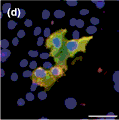Chemistry, Department of: Faculty Series

Ronald Cerny Publications
Document Type
Article
Date of this Version
9-1-2005
Abstract
Histone Lys methylation plays an important role in determining chromatin states and is mostly catalyzed by SET domain– containing proteins. The outcome, transcriptional repression or activation, depends on the methylated histone residue, the degree of methylation, and the chromatin context. Dimethylation or trimethylation of histone H3 Lys 4 (H3K4me2 or H3K4me3) has been correlated with transcriptionally competent/active genes. However, H3K4 methylation has also been implicated in gene silencing. This dualistic nature of the H3K4 methyl mark has thus far remained unresolved. In the green alga Chlamydomonas reinhardtii, Mut11p, related to a subunit of trithorax-like methyltransferase complexes, is required for transcriptional silencing. Here, we show that Mut11p interacts with conserved components of H3K4 methyltransferase machineries, and an affinity-purified Mut11p complex(es) methylates histones H3, H2A, and H4. Moreover, a Mut11 mutant showed global loss of monomethylated H3K4 (H3K4me1) and an increase in dimethylated H3K4. By chromatin immunoprecipitation analysis, this strain also displayed substantial reduction in H3K4me1 and enrichment in H3K4me2 associated with transcriptionally derepressed genes, transgenes, and retrotransposons. RNA interference–mediated suppression of Set1, encoding an H3K4 methyltransferase, induced similar phenotypes, but of lower magnitude, and no detectable increase in H3K4me2. Together, our results suggest functional differentiation between dimethyl H3K4 and monomethyl H3K4, with the latter operating as an epigenetic mark for repressed euchromatin.


Comments
Published in The Plant Cell, Vol. 17, 2439–2453, September 2005, www.plantcell.org © 2005 American Society of Plant Biologists.
The document contains an abstract and active link to the publisher's open-acces version of the article.
Article, publication date, and citation information can be found at www.plantcell.org/cgi/doi/10.1105/tpc.105.034165.